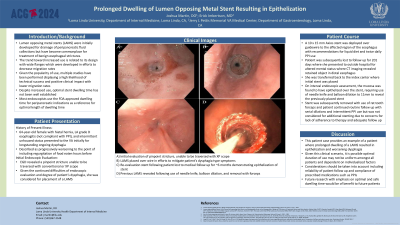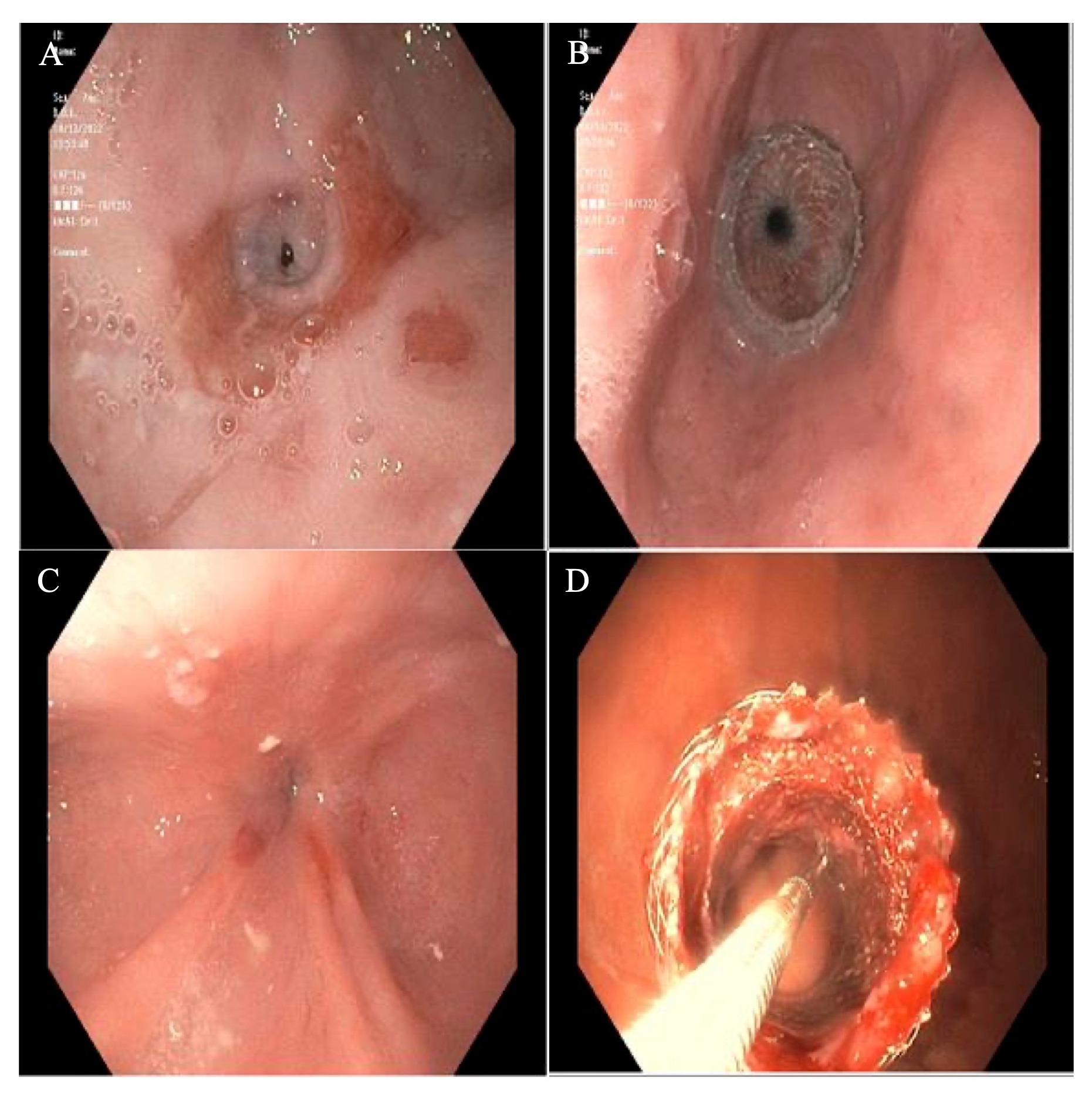Monday Poster Session
Category: Esophagus
P2280 - Prolonged Dwelling of Lumen Opposing Metal Stent Resulting in Epithelization
Monday, October 28, 2024
10:30 AM - 4:00 PM ET
Location: Exhibit Hall E

Has Audio
.jpg)
Joshua J. Martin, DO (he/him/his)
Loma Linda University Health
Loma Linda, CA
Presenting Author(s)
Joshua J. Martin, DO1, Erick Imbertson, MD2
1Loma Linda University Health, Loma Linda, CA; 2VA Loma Linda Healthcare System, Loma Linda, CA
Introduction: Lumen apposing metal stents (LAMS) were initially developed for transmural drainage of peripancreatic fluid collections but have become commonplace in the treatment of refractory benign esophageal strictures.1 The trend toward its use is related to its design including wide flanges which were developed in efforts to decrease migration rates.1 With its increased use multiple studies have been performed both displaying the high likelihood of technical success as well as positive clinical impact including lower migration rates.2,3 Despite its increased use, optimal stent dwelling time has not been established with current guidelines recommending stent placement for treatment of refractory strictures without comment on type or duration.4 Despite no firm recommendations, some studies have used endoscopist discretion and others the FDA approved dwelling time for peripancreatic indications as a marker for potential safe dwelling duration.5,6 We present a case of a patient with stent placement for 201 days due to lack of follow up who presented for worsening dysphagia.
Case Description/Methods: 64-year-old female with a hiatal hernia and LA grade D esophagitis presented to the VA for ongoing dysphagia and poor oral intake. Initial endoscopic evaluation revealed retained food and liquid in the esophagus with evidence of a pinpoint stricture, as such the patient was considered for LAMS placement. XP scope was used in efforts to transverse the stricture, which was unsuccessful, 10 x 15 mm Axios stent was placed over guidewire and deployed in the affected region of the esophagus. She was subsequently lost to medical follow up until presentation to outside hospital for altered mental status. On repeat endoscopy mucosa had overgrown the entirety of the stent making it unable to be visualized. Needle knife was used to delineate the stricture and balloon dilation to 11mm was performed allowing the retained stent was able to be removed. Her follow up remained more consistent following removal of the stent with multiple serial dilations performed for therapeutic treatment of continued stricture.
Discussion: This patient case provides an important example that safe dwelling time for LAMS may not be uniform across all patients. Considerations must be taken into account including patient follow up and compliance of prescribed medications such as PPIs. A point of emphasis on optimal and safe dwelling time in future research would likely provide benefit to future patients.

Disclosures:
Joshua J. Martin, DO1, Erick Imbertson, MD2. P2280 - Prolonged Dwelling of Lumen Opposing Metal Stent Resulting in Epithelization, ACG 2024 Annual Scientific Meeting Abstracts. Philadelphia, PA: American College of Gastroenterology.
1Loma Linda University Health, Loma Linda, CA; 2VA Loma Linda Healthcare System, Loma Linda, CA
Introduction: Lumen apposing metal stents (LAMS) were initially developed for transmural drainage of peripancreatic fluid collections but have become commonplace in the treatment of refractory benign esophageal strictures.1 The trend toward its use is related to its design including wide flanges which were developed in efforts to decrease migration rates.1 With its increased use multiple studies have been performed both displaying the high likelihood of technical success as well as positive clinical impact including lower migration rates.2,3 Despite its increased use, optimal stent dwelling time has not been established with current guidelines recommending stent placement for treatment of refractory strictures without comment on type or duration.4 Despite no firm recommendations, some studies have used endoscopist discretion and others the FDA approved dwelling time for peripancreatic indications as a marker for potential safe dwelling duration.5,6 We present a case of a patient with stent placement for 201 days due to lack of follow up who presented for worsening dysphagia.
Case Description/Methods: 64-year-old female with a hiatal hernia and LA grade D esophagitis presented to the VA for ongoing dysphagia and poor oral intake. Initial endoscopic evaluation revealed retained food and liquid in the esophagus with evidence of a pinpoint stricture, as such the patient was considered for LAMS placement. XP scope was used in efforts to transverse the stricture, which was unsuccessful, 10 x 15 mm Axios stent was placed over guidewire and deployed in the affected region of the esophagus. She was subsequently lost to medical follow up until presentation to outside hospital for altered mental status. On repeat endoscopy mucosa had overgrown the entirety of the stent making it unable to be visualized. Needle knife was used to delineate the stricture and balloon dilation to 11mm was performed allowing the retained stent was able to be removed. Her follow up remained more consistent following removal of the stent with multiple serial dilations performed for therapeutic treatment of continued stricture.
Discussion: This patient case provides an important example that safe dwelling time for LAMS may not be uniform across all patients. Considerations must be taken into account including patient follow up and compliance of prescribed medications such as PPIs. A point of emphasis on optimal and safe dwelling time in future research would likely provide benefit to future patients.

Figure: (A) Pinpoint stricture before stent; (B), pinpoint stricture following stent;
(C), Pinpoint stricture over epithelialized stent; (D), epithelialized stent following dilation.
(C), Pinpoint stricture over epithelialized stent; (D), epithelialized stent following dilation.
Disclosures:
Joshua Martin indicated no relevant financial relationships.
Erick Imbertson indicated no relevant financial relationships.
Joshua J. Martin, DO1, Erick Imbertson, MD2. P2280 - Prolonged Dwelling of Lumen Opposing Metal Stent Resulting in Epithelization, ACG 2024 Annual Scientific Meeting Abstracts. Philadelphia, PA: American College of Gastroenterology.
